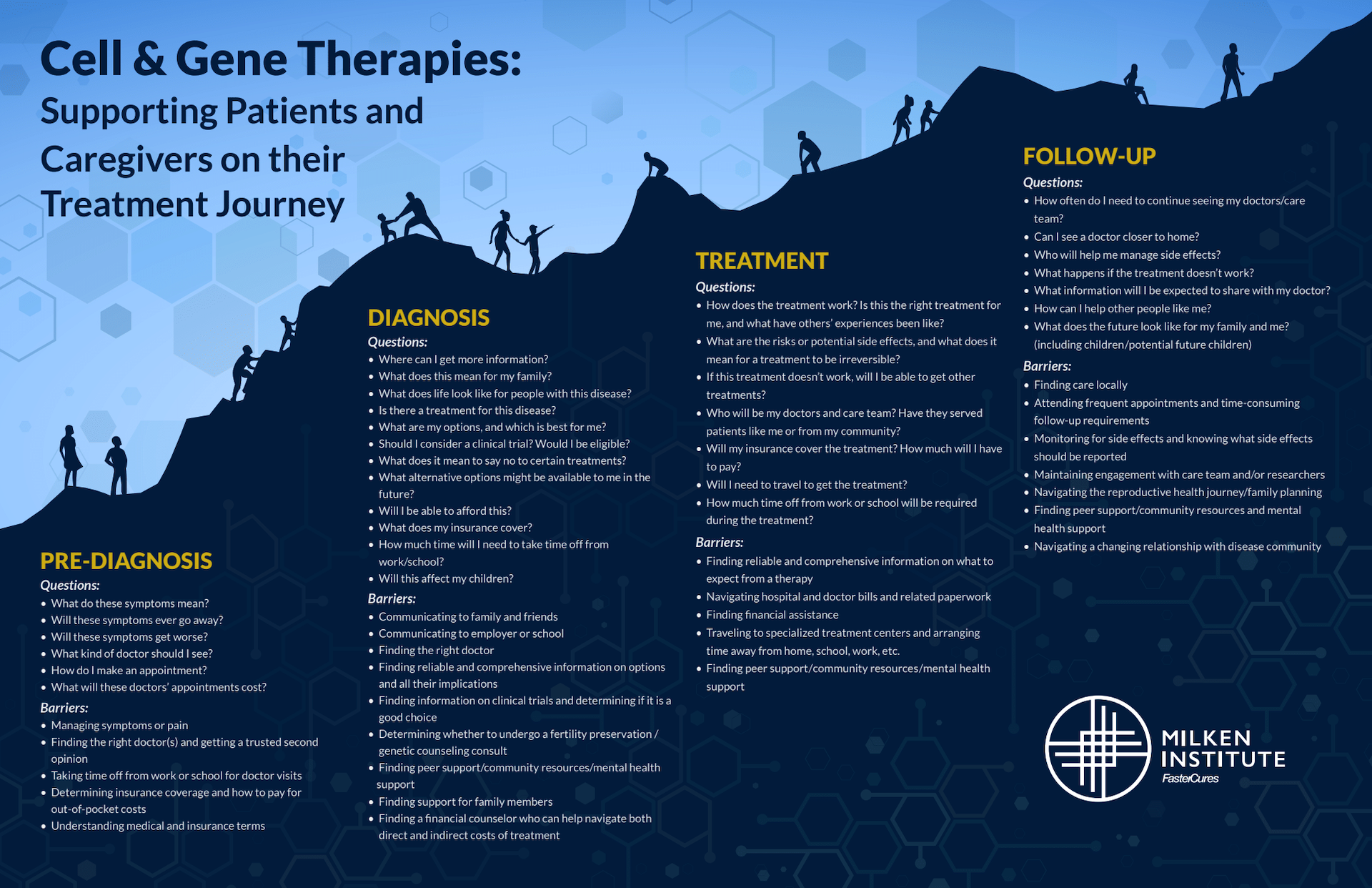
Introduction
Advances in cell and gene therapies are transforming how we treat or potentially cure disease. Cell and gene therapies aim to address the underlying cause of genetic and acquired diseases. Gene therapies involve the introduction, removal, or change in the content of a person’s genetic code, while cell therapies involve the transfer of cells into a patient. With dozens of new cell and gene therapies expected to be approved by the FDA in the coming years, ensuring these therapies benefit all the individuals for whom they are intended will be a complex task for providers, payers, and product developers. With this in mind, FasterCures sought to create a resource that could elucidate the challenges that patients and caregivers may confront during the course of their care journey.
Based on input collected during two workshops held in November 2020 and April 2021 and stakeholder interviews, FasterCures developed a journey map to delineate many of the questions that arise for patients and caregivers when confronted with an option of a cell or gene therapy. This map is intended to: serve as a resource to facilitate conversations between patients and providers; offer a framework to those developing tools and resources that seek to provide support to patients, providers, payers, and others; and provide insight into the intangible but costly burdens of disease on patients and caregivers.
Mapping the Patient and Caregiver Journey for Cell and Gene Therapies
Journey maps are frequently used as a tool to visualize the complex and multi-faceted experience of patients when seeking and receiving care. Delineating the steps of a patient’s journey can help others develop a stronger understanding of the patient experience and identify areas where that experience might be improved.
A patient journey map can reveal logistical, informational, financial, and emotional challenges that are often overlooked. According to EveryLife Foundation’s Burden of Rare Disease Study, the economic burden of rare diseases in the U.S. was nearly $1 trillion in 2019. The majority of this burden is from indirect costs (e.g., productivity loss) and non-medical or uncovered costs (e.g., transportation or home/auto modifications). When patients cannot access needed care in a timely and efficient manner, the cost to the healthcare system is much greater than estimates of direct medical costs would suggest.
In the case of cell and gene therapies, their novelty introduces different and more complex challenges than traditional medicines. For example, many patients may not become aware of the availability of these emerging treatment options, especially those living in areas where access to healthcare is low. Further, patient organizations, which serve as a vital source and conduit of information, may not have the same level of experiential knowledge on new cell and gene therapies to share with their communities, especially in the initial months of a product’s approval. The understanding of providers and payers, too, will take time to develop.
Reading and Considering FasterCures’ Patient and Caregiver Journey Map
FasterCures created a journey map with the aim of delineating some of the fundamental questions that patients and caregivers may have on their care journey. The journey map is built around the four major stages of a patient journey: pre-diagnosis, diagnosis, treatment, and follow-up. We sought to make the perspective and voice of the patient and caregiver an essential element of the journey map (represented as “questions” within each stage). Under “barriers” within each stage, we articulate potential areas of challenge where assistance or resources would be useful.
Key Considerations
The full scope and complexity of the patient journey cannot be captured in a single graphic. In particular, we recognize that systemic barriers in our healthcare system mean that this journey will look very different depending on the individual. These systemic barriers include: inadequacy or lack of insurance coverage; lack of geographic availability and accessibility of treatments; structural racism causing inequalities in healthcare access; and lack of culturally competent care.
In addition, there is considerable variability in cell and gene therapies. This journey map is intended to serve as a general resource, but we acknowledge that patient and caregiver concerns and experiences may vary significantly based on disease, the availability of treatment options, or on type of therapy (e.g., autologous/allogeneic cell therapy or in vivo/ex vivo gene therapy). Patient and caregiver experiences may also vary significantly based on the age at which a disease is diagnosed or whether it is a recent or long-standing diagnosis.
Potential Uses of the Journey Map
FasterCures envisions this journey map can be used in multiple ways:
Patients and caregivers: to facilitate dialogue with providers and insurers on what to expect and how to get support.
Providers: to anticipate the questions that patients and caregivers may have so that they can be prepared to provide accurate and comprehensive answers.
Payers: to determine where additional resources may be needed to ensure the achievement of optimal outcomes.
Manufacturers: to inform the creation of informational resources for patients, providers, and payers.
FasterCures is grateful to those who participated in the November 2020 and April 2021 workshops and individual interviews for their contributions to the ideas summarized in this brief. We would especially like to thank Annie Kennedy of EveryLife Foundation and Casey Quinn of MITNewDigs for their research and guidance that informed our work.
About FasterCures’ Cures for Life Project
The Cures for Life project brings all stakeholders to the table to address challenges related to the emerging landscape of cell and gene therapies and to elevate the patient’s voice in access to these transformative therapies. While only a small number are currently approved, many cell and gene therapies are expected to receive approval in the coming years. To ensure these therapies reach the patients that need them, healthcare stakeholders are considering how current processes and policies may need to be adapted to accommodate these innovative medicines. Cures for Life convenes workshops and roundtables on specific issues that affect patient access to cell and gene therapies, highlighting approaches and solutions that are emerging in each area. In 2020, we held two workshops (in February and July) focused on the issue of data collection for long-term follow-up. We also held a roundtable in March of 2021 focused on the manufacturing of cell and gene therapies.
